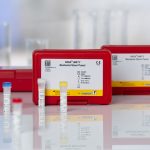Intended use:
For in-vitro diagnostic use.
The RIDA®GENE Lac Intol test, which is performed on the LightCycler® 480 II, is a multiplex real-time PCR for the qualitative detection and differentiation of C13910 & G22018 as well as their SNPs (single nucleotide polymorphisms) C13910T & G22018A in the human MCM6 gene from human whole blood EDTA samples from persons with signs and symptoms of lactose intolerance.
The RIDA®GENE Lac Intol test is intended to aid in the diagnosis of patients with symptoms of lactose intolerance in connection with other clinical and laboratory findings.
The test result should not be used as the sole basis for diagnosis.
The product is intended for professional use.
General information:
Lactose, a disaccharide made up of galactose and glucose, is the main energy source of milk in humans and animals.
The β-(1,4) glycosidic bond can be broken down by the enzyme lactase, thereby making the monosaccharides available for further use. Breakdown and adsorption take place in the small intestine. The monosaccharides are subsequently transported inside the epithelial cells (enterocytes). The amount of lactase increases during pregnancy and reaches its highest value a few days after birth. Lactase content decreases over a lifetime through regulators at the genetic level. Yet 50 % of lactase activity is sufficient to break down lactose effectively. If lactose can only be broken down in small quantities or not at all, this leads to an excessive osmotic load and increases the water content in the intestine. Furthermore, lactose gets into the large intestine, where it is fermented by intestinal bacteria, contributing to the production of short-chain fatty acids and gases such as hydrogen, carbon dioxide, and methane. This, in turn, can cause clinical symptoms such as bloating, abdominal pain, cramps and/or postprandial fullness, belching, diarrhea and in some cases constipation, nausea, and vomiting. The gene that codes for lactase is called LCT and is located on chromosome 2. The MCM6 (minichromosome maintenance complex component 6) gene, which is located approx. 14 Kb upstream of the lactase gene, functions as an enhancer. Different single nucleotide polymorphisms (SNPs) including 13910 C/T and 22018 G/A in this gene are associated with lactase persistence. This change leads to new transcription factor binding sites, thus contributing to a lifelong expression of the LCT gene. Lactose intolerance is therefore not a disease; it has a global prevalence of 57 % and higher. This varies from region to region. Europe has an average prevalence of 28 %, varying from 2 % in Scandinavia and 70 % on Sicily.
| Art. No. | PY4215 |
|---|---|
| Test format | real-time PCR with 100 reactions |
Dear customers,
we have started to provide the documents for our products in an electronic format. These are the Instructions for Use (IFU), the Safety Data Sheets (SDS) and the Certificate of Analysis (CoA). For batches placed on the market after 01 January 2023, you can find our documents on the eIFU portal eifu.r-biopharm.com/clinic.










